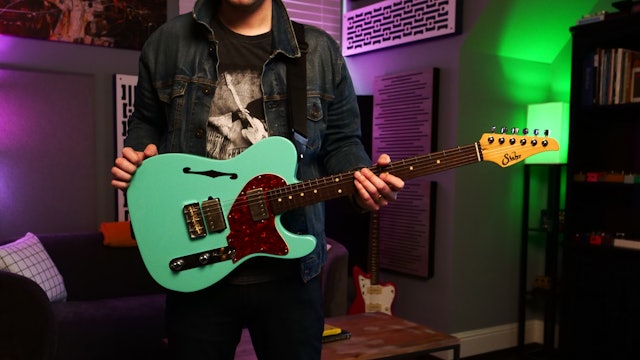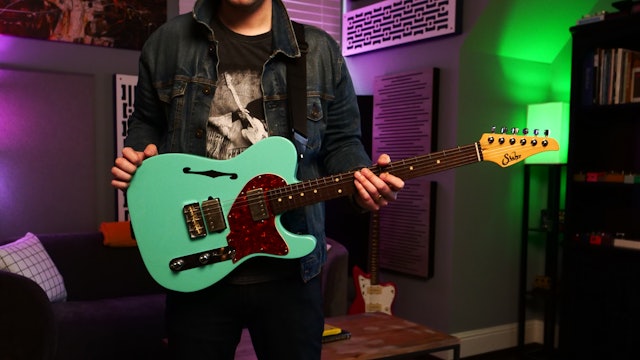Music Theory: Level 3
You can find all downloadable resources at the end of each curriculum in Guitar Super System, or altogether for use outside the app at https://musiciswin.com/resources
You’ll need a strong understanding of basic to intermediate music theory to move through this curriculum, and I recommend skimming through Music Theory: Level 1 & 2 to fill in any gaps. You’ll learn to play the seven modes of the Harmonic Minor Scale, Whole Tone Scale, and the theory behind it, including diatonic chords, triads and all four string sets, arpeggios in multiple octaves, and as always, how to uses these concepts in your own guitar playing.
-
Introduction to the Harmonic Minor Scale
The Harmonic Minor Scale has a certain stereotype to most guitar players. It seems to me whenever you mention Harmonic Minor to a guitar player, the Malmsteen-style Phrygian dominant approach inevitably gets brought up. There's nothing wrong with that–I love Yngwie Malmsteen’s guitar playing–but ...
-
Harmonic Minor Scale Positions
I have a couple kind of favored positions when it comes to these three-note-per-string scales as far as harmonic minor goes. For example, I actually really actually enjoy the root position. And then of course you’ll also recognize the Phrygian dominant mode which is located in the fifth position...
-
Harmonic Minor Scale Playing Examples
Harmonic minor is an essential scale that is used to outline minor chords in your solos when you want to bring a unique and ominous sound to your guitar playing. One of the three big scales in modern music, alongside major and melodic minor, harmonic minor is heard in jazz, fusion, metal, and oth...
-
Harmonic Minor "Home Riffs" Demonstration
Wrapping your fingers around scales can be a little frustrating in the beginning stages, especially when you're trying to find your voice on the guitar, but still enjoy what you're hearing. In Guitar Super System, I use a strategy called “home riffs” to broaden the comfort zone of an improvising ...
-
The Altered Dominant Sound (part 1)
The Altered Dominant "scale" is actually just a mode shape of the Melodic Minor scale. The reason it's thought of as it's own tonality may have something to do with the ergonomics of the shape, or the accessibility of the interval arrangement of that particular position being more useful in a tra...
-
The Altered Dominant Sound (part 2)
While the Altered Dominant sound is actually a mode from the Melodic Minor scale, you'll hear how it can be equally useful when thought of as its own entity. Now that you have the Melodic Minor Scale positions under your fingers, dive deeper to put your the seventh position, the Altered Dominant ...
-
Introduction to Spread Voice Triads
Spread voice triads are not exactly like jelly–you don't spread them over things. On the contrary, they're more like hot sauce, as they are applied in a more "dashing" motion. Okay, now I'm getting hungry... but not for hot sauce jelly. Essentially, spread voice triads are chords, just with piece...
-
Spread Voice Triad Exercises
The teachings in this lesson are the foundation for higher education in music, and the concept is simple: triads. Triads are the foundation for chords, which in turn means they are extremely important to be aware of as you construct your music, whether that is through songwriting, improvising, or...
-
Learning Spread Voice Triads with Hendrix
As many of you probably know, Jimi Hendrix was a big fan of triads, in all their iterations. Spread voiced triads are especially useful when you want a bit more open sounding compliment to the music happening around you.
-
Using Triads in Real Songs
In case you missed it, I donned the garb of Metallica's James Hetfield and the legend himself, Jimi Hendrix, for an epic guitar duel where I mashed up each artists songs. The overwhelming majority of your comments demanded an explanation and extended play on the Nothing Else Matters meets Little ...
-
Learning the Diatonic Chords of Harmonic Minor
We're talking about the Harmonic Minor chords the diatonic chords that make up the harmonic minor sound in this lesson, and of course there are seven of them – one for each mode of Harmonic Minor Scale. Some of these chords sound a little crazy… in case you haven't noticed, Harmonic Minor is a li...
-
Getting Acquainted with Suspended Chords
Have you ever wondered where these magical "sus" chords can fit into your guitar playing? In this lesson, I'll demonstrate how both sus2 and sus4 chords can impact various chord progressions and establish different moods in your music.
-
"Expensive" Guitar Chords
Here's a handful of some of the slickest, most "expensive" guitar chords on the fretboard. These are particularly beautiful selections from the Complete Chord Library you’ll find in Guitar Super System, meant to provide some inspiration for you. Sometimes, all it takes is one note to spark someth...
-
18. Four Part Chord Sight Reading Exercise
Use this interactive video as a way to practice anticipating chord changes as a more modern approach to working on your sight reading of chords.
-
This is Your Brain on Music Theory
Take a glimpse inside my mind as I catapult from one place to the next, traversing the endless labyrinth of music theory in hopes of finding a truly unique end result. I love putting my own spin on chord progressions from popular songs, because while some music should be played note for note as a...
-
Arpeggiating Chords to Break Scale Boxes
Working on sounding more musical with scales is an ongoing process, as it’s easy to get stuck in the habit of simply playing up and down various positions in a somewhat robotic fashion. While this is where everyone starts while learning to improvise, it isn’t where you have to remain. Arpeggiatin...
-
Blending Arpeggios and Scales
To expand on the notion of arpeggiating the chord you’re playing over in order to implement arpeggio shapes into your guitar playing, this lesson is meant to show you specific examples of how you can combine arpeggios and scalar playing to express different musical ideas. No matter what genre you...
-
Harmonic Minor Arpeggio Practice Backing Track
Use the video to anticipate upcoming chords in the progression and utilize your knowledge of the Harmonic Minor Scale to target chord tones among the harmony.
-
Natural, Melodic, and Harmonic Minor - A Comparison
Learn about or gain a new perspective on the three most foundational minor scales. Be sure to use the backing tracks to explore the sound of each of these scales and utilize the downloadable PDFs! Feel free to revisit the Music Theory sections of Guitar Super System for more information on each o...
-
E-Natural,-Melodic,-and-Harmonic-Minor-BT.mp3
4.25 MB
-
Melodic-Minor-Modes-3-Notes-Per-String.pdf
150 KB
-
Harmonic Minor Scale Positions.pdf
157 KB























